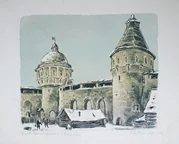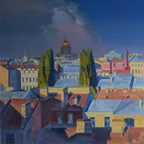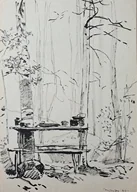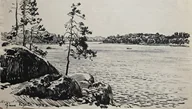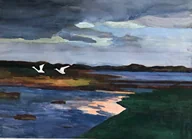Ivan Yakovlevich Bilibin (August 4 [16], 1876, Tarkhovka, St. Petersburg Uyezd, St. Petersburg Province, Russian Empire - February 7, 1942, Leningrad, RSFSR, USSR) - Russian artist, book illustrator and theater designer, member of the Mir association art. He was born on August 4 (16), 1876 in the village of Tarkhovka Sestroretsk, (near St. Petersburg), in the family of a naval doctor Yakov Ivanovich Bilibin.
In 1888 he entered the First St. Petersburg Classical Gymnasium, which he graduated with a silver medal in 1896. In 1900 he graduated from the Law Faculty of St. Petersburg University. In 1895-1898 he studied at the drawing school of the Society for the Promotion of Arts. In 1898, he studied for two months in the studio of the artist Anton Ashbe in Munich. For several years (1898-1900) he studied under the guidance of Ilya Repin in the school-workshop of Princess Maria Tenisheva, then (1900-1904) under the leadership of Repin at the Higher Art School of the Academy of Arts. He lived mainly in St. Petersburg. After the formation of the art association «World of Art» becomes an active member.
In 1899, Bilibin accidentally came to the village of Yegny of the Vesyegonsky district of the Tver province. Here he first creates illustrations in the later Bilibino style for his first book, The Tale of Tsarevich Ivan, the Firebird and the Gray Wolf. In 1902, 1903 and 1904, Bilibin visited the Vologda, Olonets and Arkhangelsk provinces, where he was commanded by the ethnographic department of the Museum of Alexander III to study wooden architecture.
Bilibin's artistic talent was clearly manifested in his illustrations for Russian fairy tales and epics, as well as in works on theatrical productions. From 1899 to 1902 he created a series of six «Tales» published by the Expedition for the Preparation of Government Securities, then the same publishing house published Pushkin's fairy tales with illustrations by Bilibin. In particular, the Tale of Tsar Saltan (1905) and the Tale of the Golden Cockerel appeared (1910). In 1905, the epic Volina, illustrated by Bilibin, was published, and in 1911, the tales of Roslavlev were published by the Public Benefit publishing house. In addition to the “fabulous” style with ancient Russian ornamental motifs is the production of the opera «The Golden Cockerel» designed by Bilibin in 1909 at the Zimin Theater in Moscow.
In the spirit of the French Mystery, he is represented by The Miracle Theophilus (1907), recreating a medieval religious drama; Spain of the 17th century was inspired by costume designs for the drama Lope de Vega «The Sheep Source», for the drama Calderon «Purgatory of St. Patrick» - theatrical production of the «Ancient Theater» in 1911. A joking caricature of the same Spain blows from the vaudeville by Fyodor Sologub «Honor and Revenge», staged by Bilibin in 1909.
Screensavers, endings, covers and other works of Bilibin are found in such magazines of the beginning of the 20th century as World of Art, Golden Fleece, in the publications of Rosehip and Moscow Book Publishing.
During the revolution of 1905, the artist creates revolutionary cartoons. Since 1907, Bilibin has been teaching the graphic art class at the school of the Society for the Promotion of Arts, continuing teaching until 1917. Among his students at the school were George Narbut, Konstantin Eliseev, L. Ya. Hortik, A. Rozileht (August Roosileht), Nikolai Kuzmin, Rene O’Connell, K. D. Voronets-Popova.
In 1912, married a second marriage to R. R. O’Connell. In the same year, a group of Moscow and St. Petersburg intellectuals bought a plot of land on the southern coast of Crimea in Batiliman to build cottages. Bilibin was one of the partners, other shareholders were writers Vladimir Korolenko, Alexander Kuprin, Sergey Elpatievsky, Evgeny Chirikov, artist Vladimir Derviz, professors Abram Ioffe, Vladimir Vernadsky, Mikhail Rostovtsev. By lot, Bilibin got a piece of land near the sea, on which there was already a fishing house. A workshop was attached to the house. After that, every year, after graduating from classes at the Society for the Encouragement of Arts school, Bilibin went to Batiliman and returned to Petersburg in the fall to the start of classes.
In 1915, he participated in the establishment of the Society for the Renaissance of Artistic Russia along with many other artists of his time. After the February Revolution, Bilibin created a sketch depicting a double-headed eagle, which was used as a temporary symbol of the Russian Republic. In 1992, a similar drawing by the artist was the basis for the emblem of the Bank of Russia.
In 1917, Bilibin broke up with his second wife, Rene O’Connell. After the October Revolution, the artist leaves for Crimea in Batiliman, where he lives until September 1919. Since 1920, Bilibin has lived in Cairo. In Egypt, he worked on sketches of panels and frescoes in the Byzantine style for the mansions of wealthy Greek merchants. He studied Egyptian art, first Muslim and Coptic, and then the art of Ancient Egypt. In February 1923, Bilibin married the artist Alexandra Vasilyevna Shchekatikhina-Pototskaya, who came to him in Cairo with her son Mstislav. In the summer of 1924 he traveled with his family in Syria and Palestine. In October 1924 he settled in Alexandria. In August 1925, Bilibin moved to Paris. At this time, he was preparing brilliant decorations for the productions of Russian operas, the artist was invited to stage Stravinsky’s Firebird ballet in Buenos Aires and a number of operas in Brno and Prague. He performed illustrations for Russian fairy tales, tales of the Brothers Grimm, tales of the Thousand and One Nights.
In 1936, the artist on the ship «Ladoga» returned to the Soviet Union and settled in Leningrad. He taught at the All-Russian Academy of Arts, continued to work as an illustrator and artist of the theater. From 1937 to 1942 he lived and worked in house No. 25 (apt. 46) along Gular Street of Leningrad (now Liza Chaykina Street), as indicated by the plaque on this house. After the start of World War II, he refused to evacuate and died in the besieged Leningrad on February 7, 1942 in a hospital at the All-Russian Academy of Arts. The last work of the famous artist was a preparatory illustration for the epic «Duke Stepanovich» in 1941. He was buried in the mass grave of professors of the Academy of Arts near the Smolensk cemetery.






